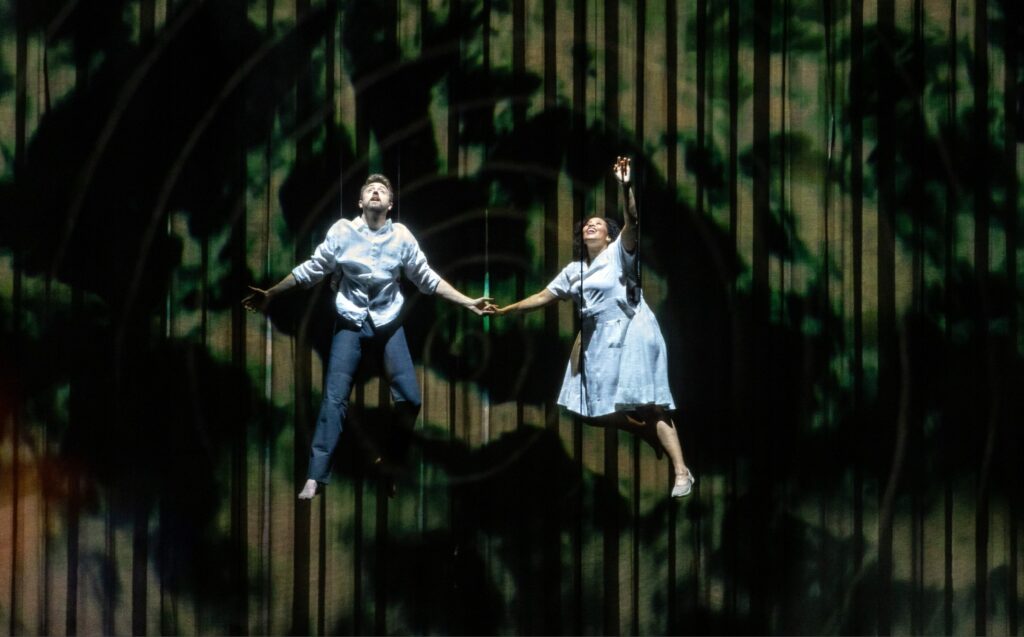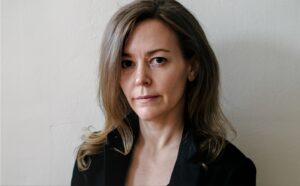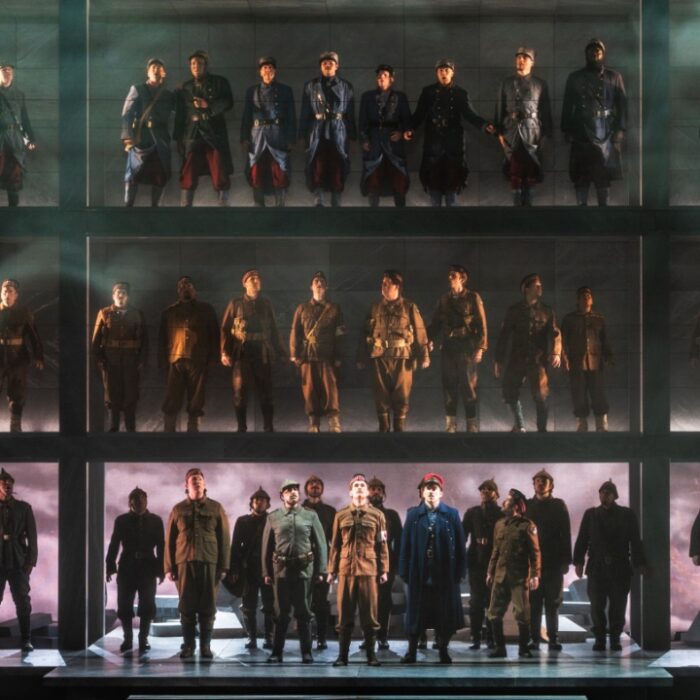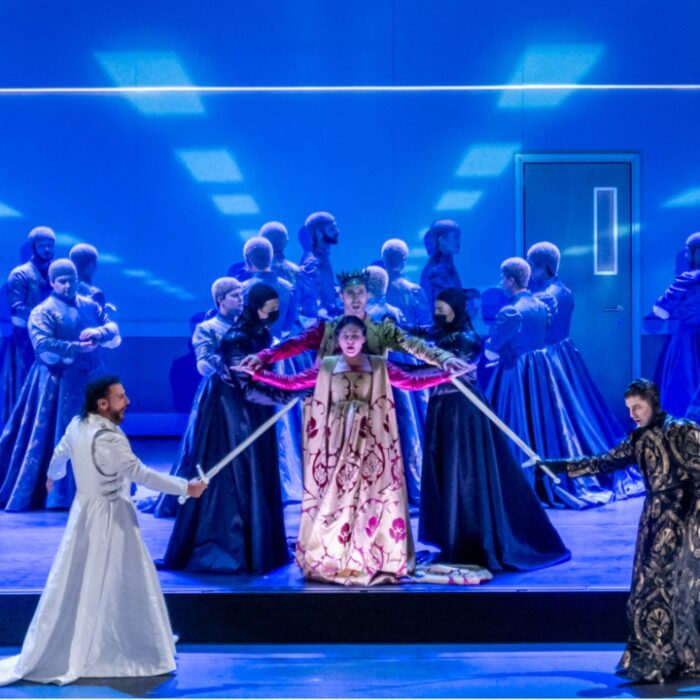
Metropolitan Opera 2024-25 Review: Die Zauberflöte
By Jennifer Pyron(Photo: Marty Sohl / Met Opera)
Simon McBurney’s German-language production of Mozart’s “Die Zauberflöte” lifts the veil between performers and audience members, making it easy to find a full-length opera (approximately three hours and 15 minutes) that is fun and interesting. OperaWire initially reviewed this production in detail for the Met’s 2022-23 season and is excited to see it included in this season’s lineup. Creative team members for this season’s production include conductor Evan Rogister, set designer Michael Levine, costume designer Nicky Gillibrand, lighting designer Jean Kalman, projection designer Finn Ross, sound designer Gareth Fry, revival stage director Paula Williams, and chorus director Tilman Michael.
The Met showcased Julie Taymour’s beloved abridged English-language production, “The Magic Flute,” just this past holiday season and, as always, received high praise for its imaginative interpretation of an opera that is under two hours long. However, when comparing these two productions of Mozart’s final opera, one might realize that making a lasting impression is not only about time: it is also about space, and how great art has the capacity to make a space for everyone.
Production Details
“Die Zauberflöte” is a singspiel (song-play) made to appeal to audience members of all ages. The transitions in Mozart’s composition, between music and speaking moments, give this opera a rare opportunity to include audience members along the way. And this is exactly what McBurney’s production does best. Upon entering the Met opera’s main hall and locating one’s seat, there is already a lot to be noticed regarding the stage’s layout, with the orchestra pit raised above ground. This makes it seamlessly accessible: anyone sitting anywhere can observe all the action. The performers are already seated to the side of the stage, orchestra members already in position, when suddenly the Met’s chandeliers rise and the music starts. Immediately there is a sense of ‘coming together’ between the audience and performers. Creativity’s power to bridge any gap has been harnessed.
Stage right is a station where visual artist Blake Habermann has free reign to use a camera, chalkboard with chalk, smoke machine, lights/shadows, figurines, and his wild imagination to project every scene onto the stage. This was one of my favorite details. His visuals came across as natural and free-flowing throughout. Habermann’s sense of humor illuminated “Die Zauberflöte’s” fairytale elements and made light out of even the darkest moments. His humanness gave life to his creations, and this nuanced detail made a world of difference from the very outset.
The same can also be said about foley artist Ruth Sullivan, located stage left, who worked in tandem with all aspects of the production, making her sounds works of art that resonated within one’s soul. Her work, rich with intuitive playfulness and depth, absolutely took my breath away. The large piece of metal that she played during the most serious parts of the opera reverberated with a guttural, low-drone bass that sent chills down my spine. I would love to hear her live performance somehow included in Benjamin Britten’s “The Turn of the Screw.”
The main stage includes a large metal/wood-floor platform suspended by four wires, one in each corner. It has lights underneath it that, at times, create dramatic effects; but mostly the stage is made dark so that the visuals and projections can be easily seen. Projection designer Finn Ross created colorful moments that blended into the overall production and supported the unity at play.
The spotlight is used very prominently and to great effect when highlighting the action. I had to look up, back at the spotlight area (presumably run by lighting designer Jean Kalman), because I was so impressed by how engaging it was. Honestly, every single person involved in the creative team is so on point that I was captivated the entire time.
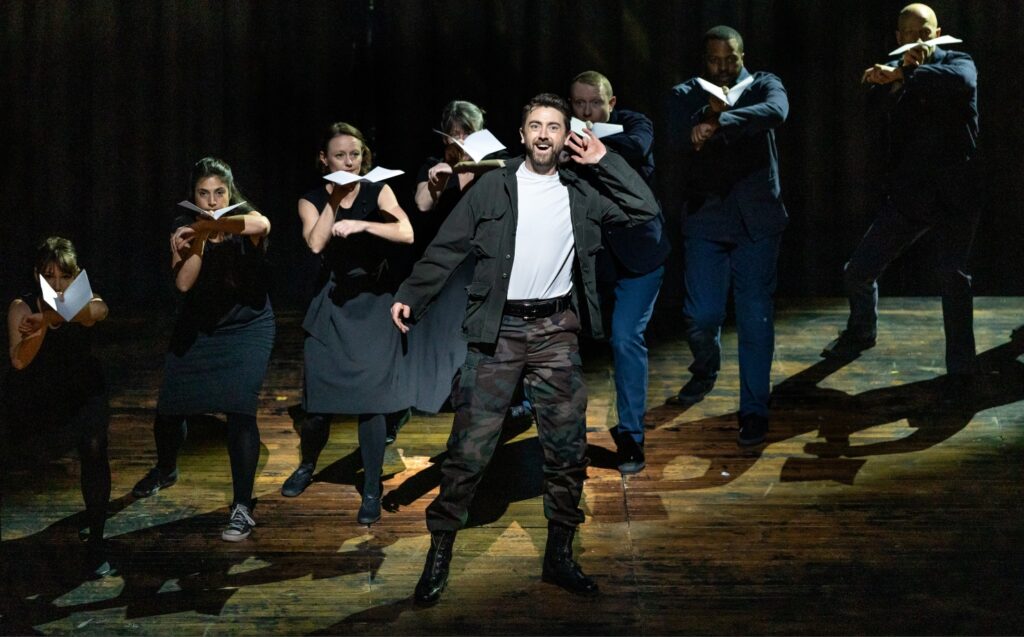
(Photo: Marty Sohl / Met Opera)
Stellar Cast
Ben Bliss as Tamino is a breath of fresh air. Bliss takes on whatever role he is given with a very grounded approach in both his acting and singing. Tamino is an easy role for any tenor to get caught up in the ‘fairytaleness’ of it all. However, Bliss makes Tamino into more of a realist with his subtle gestures, facial expressions, and nuanced side-eye when the narrative takes its crazy twists and turns. Admittedly, a lot of my impression concerning Bliss in this role stems from his performance in the Met’s production of Jeanine Tesori and George Brant’s “Grounded” earlier this season. I cannot help but associate Bliss with his underlying intelligent sense of humor, which I see seep into whatever role he is portraying; and I feel this is a good thing, especially for the opera world. When I learned that Bliss was performing as Tamino, I looked forward to attending this production because Bliss is someone who shares a similar sense of humor and like-mindedness that would not make his performance another superfluous example of ‘how opera just is.’ Instead, Bliss shows us how opera can be when the conscious effort is made to connect with what makes one’s performance resonate the most with the audience: giving an excellent vocal performance and having a supportive attitude towards sharing the performance space with ones colleagues. He makes any space he is in feel a bit brighter and lighter.
Bliss’s voice sounded warm and distinguished in the Met hall. His timbre is unique and when he sings there is a matter-of-factness in his quality. His aria “Dies Bildnis ist bezaubernd schön” illuminated his tessitura’s agility, translating for the audience with ease. “O wenn ich doch” was a gentle moment, yet straight to the point. His ability to maneuver physically about the stage is also a plus in this role. The suspended plank mentioned earlier took a wild turn when it began to levitate and alternate heights so that performers on it would run and slide from side to side, back and forth, just to keep up with its fluctuations. In this fashion Bliss remained on edge, making Tamino more human and less of a ‘show pony.’ All in all, this was the most intentionally energetic Tamino I have yet witnessed!
The Three Ladies, Alexandria Shiner, Olivia Vote, and Tamara Mumford, did an excellent job keeping up with the fast pace of the production. Their voices were radiant and carried over the orchestra with ease. Soprano Alexandria Shiner is a vocal knock-out and I could not tear my ears away from her, wanting to hear more of her voice in a larger role.
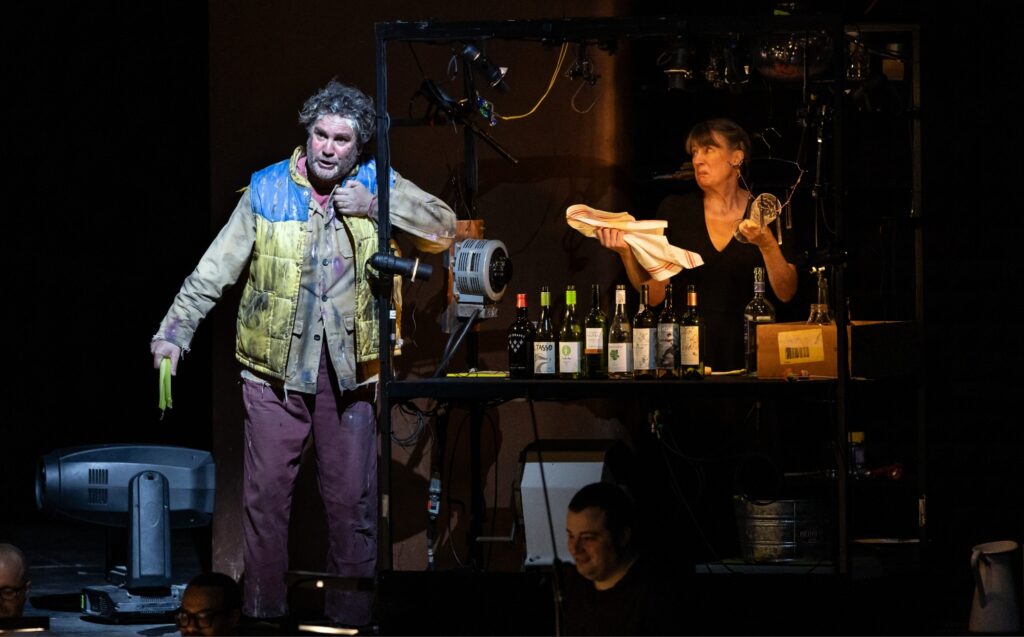
(Photo: Marty Sohl / Met Opera)
Baritone Thomas Oliemans as Papageno gave an outstanding performance. OperaWire’s initial review of this production goes into detail about his work, and this season’s performance is another solid example. However, what stood out the most to me, besides Oliemans’s beautiful voice, is his capacity to multitask and manage time. Every moment of his performance felt very calculated and precise, giving a sense of urgency to his character’s typical chaotic and hilarious nature. This was a game changer in my opinion. Oliemans knows this production like the back of his hand, yet instead of resting upon the laurels of excellent past performances I believe he strives to do even better every time he performs as Papageno. For the very first time, I experienced this role as fascinating and fun, because I learned from the choices he made as a performer to achieve ‘the perfect cadence’ and his ability to make a single note’s tone different to add an extra spark.
When I think back on the role of Papageno, I remember Rolando Villazón’s iconic performance in Julie Taymour’s “The Magic Flute,” and how he made this role such a joy to experience just by being himself and leaning into his gift of mentoring in whatever he does. In this same way, I would categorize Oliemans as someone with the gift of being an iconic Papageno. The audience could not take their eyes off him and applauded him with a standing ovation at the curtain call. I am lucky to have witnessed his live performance in action!
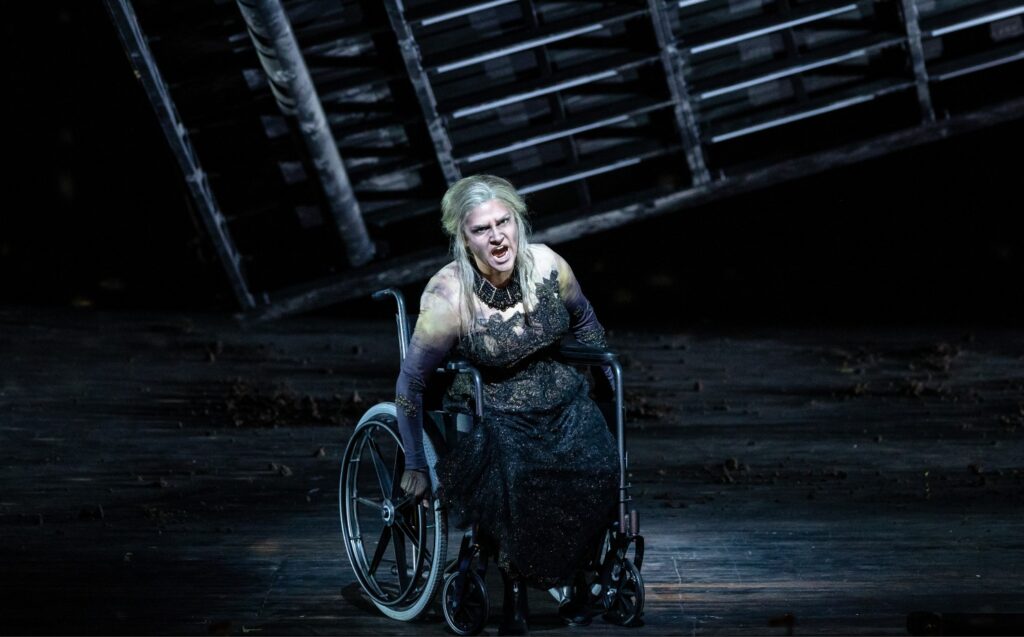
(Photo: Marty Sohl / Met Opera)
Kathryn Lewek IS the Queen of the Night
Kathryn Lewek as Queen of the Night deserves her own section in this review. Lewek’s performance in this production is beyond anything I’ve witnessed her do thus far. Her vocal performance was truly excellent. Her high notes soared into the Met’s main hall and I saw jaws drop among the audience, some even turning to their seat partners to make sure they had heard her too. Honestly, this was Lewek’s best performance that I have experienced and I wonder if it is because of how this Queen is portrayed: a frail, aging, vengeful, deteriorating form with only her own passionate bitterness and spiteful vengeance to fuel her. The amount of desperation that this Queen radiates in her desire for revenge leaves nothing on the table. She has nothing to lose, and I believe this is what pulled the ground out from under Lewek herself, giving her the space to do her best. In Julie Taymour’s “The Magic Flute,” Lewek is seen on a pedestal, fit with elaborate costuming and visual effects to magnify her power. In McBurney’s production she is the exact opposite, and it makes me pause to think more about these differences. The physicality of her in a wheelchair is something that blows my mind. Her diaphragm was only given half the usual space to provide what is necessary to sing a note loud enough to make it into the Met’s main hall. For me, Lewek is a legend and if one has the opportunity to see her perform this role in either productions, please take it!
Her arias “O zitt’re nicht… Zum Leiden bin ich auserkoren” and “Der Hölle Rache kocht in meinem Herzen” will go down in history as the best of the best. The Met also livestreamed this particular performance on their website (metopera.org) and the SiriusXM app.
(Photo: Marty Sohl / Met Opera)
More Cast Highlights
Golda Schultz’s Pamina is a young woman overwhelmed by her environment, seeking to experience the power of her heart’s true love. This production brings forward the trials that Pamina faces, and the dark side of “Die Zauberflöte’s” underlying theme is stated at the top of the program’s Act One synopsis: “The opera takes place in a mythical, fairy-tale country as magical and transformative as the stage itself. A conflict is going on, the details of which are revealed moment by moment. Two factions are at war. The story is about how to resolve the conflict and what divides them.”
As the synopsis plays out and Pamina’s perspective shifts, she begins to learn what it is that she wants in her life. However, the forces around her, mainly her mother and Monostatos, condemn her wellbeing and try to manipulate her with their own vengefulness. Schultz actively participates in realizing Pamina’s journey, but I felt the pacing of the action around her took away from her ability to really shine. Schultz’s voice displays a wide spectrum of emotional complexities and colors. This was most noticeable in her aria “Ach, ich fühl’s, es ist verschwunden.” However, the fast paced and very physical nature of McBurney’s production breezed past what makes Pamina interesting and unique: her vulnerability, softness, beauty, innocence, and desire to learn from her experiences. There were moments when the opera became a vacuum of unconsciousness and hilarity that surrounded the ‘silliness’ of conflict. But I wanted more moments in this production that gave space and light to Pamina so that one could connect with her on a deeper level and not just associate her with Tamino or the Queen of the Night or Monostatos or any other character.
Schultz has the innate presence to determine Pamina’s agency, and this is is what I ultimately wanted to experience from her performance.
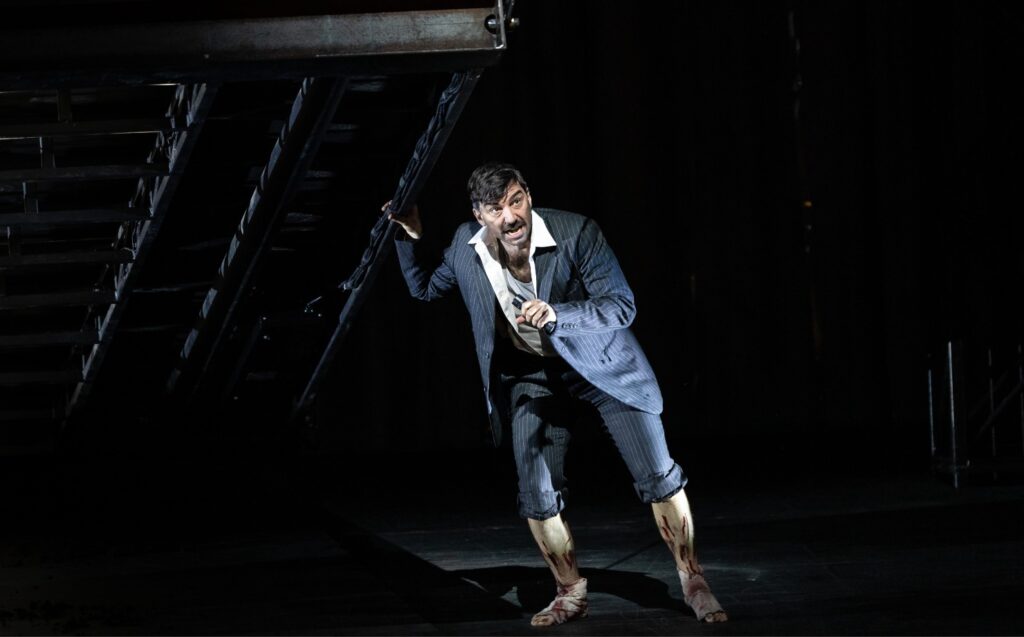
(Photo: Marty Sohl / Met Opera)
Thomas Ebenstein as Monostatos is exactly what I imagine as a modern day villain: an egotistical capitalist hell-bent on getting what he wants how he wants it, no matter the amount of destruction it takes to get there. Ebenstein’s vocal performance illuminated his character portrayal and I was enthralled by him the entire night, especially during his aria “Alles fühlt der Liebe Freuden.” His level of desperation aligned with Lewek’s Queen of the Night, but there was a sadness in his voice that made his role more interesting than usual, and very human. Despite how much this opera makes him out to be one the most hated of all the roles, Ebenstein made me want to experience him more. He arrived at the precipice of his own evolution and this made him stand out in the best way possible.
Stephen Milling as Sarastro gave a knockout vocal performance. His arias “O Isis und Osiris” and “In diesen heil’gen Hallen” filled the Met’s main hall with his rich bass voice. Beloved for his Wagnerian repertoire, Milling is always a delight to experience live. He shares a sense of comfort and ease as Sarastro and I felt that Schultz responded to his demeanor as though he were her mentor. I really enjoyed this special connection.
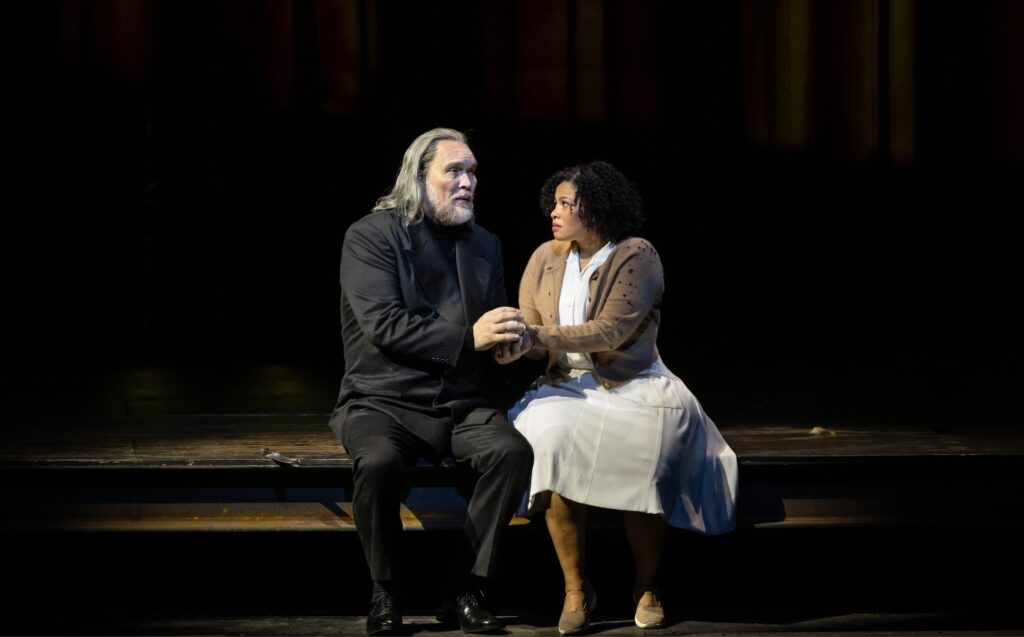
(Photo: Marty Sohl / Met Opera)
The three boys, Nico Hwang, Marcus Agrippa, and Ori Wosner were extra creepy in this production and it only added to the absurdity of “Die Zauberflöte’s” fairytale comedy. Their voices sounded pure and bright amidst the complex chaos surrounding them. They came across as ethereal and extraterrestrial in the best way possible. The priests, Richard Bernstein and Errin Duane Brooks, gave excellent performances and Brooks’ tenor voice sounded especially outstanding in the Met hall. I want to hear more of him in larger roles.
Magdalena Kuźma as Papagena is iconic. In both productions, she is the best of the best in this role. Her playful, light spirit as both the old woman and young Papagena makes her extra comical and her voice leaves a lasting impression in every performance. She is who I think of when I imagine Papagena, and I always draw upon her performances as sources of nostalgia and wonder.
Glockenspiel soloist, Katelan Trần Terrell, and flute soloist, Chelsea Knox, are another major highlight of this production. The audience gets to see them in action and onstage with the performers. This is a chance for operagoers to appreciate their work up close and in person!
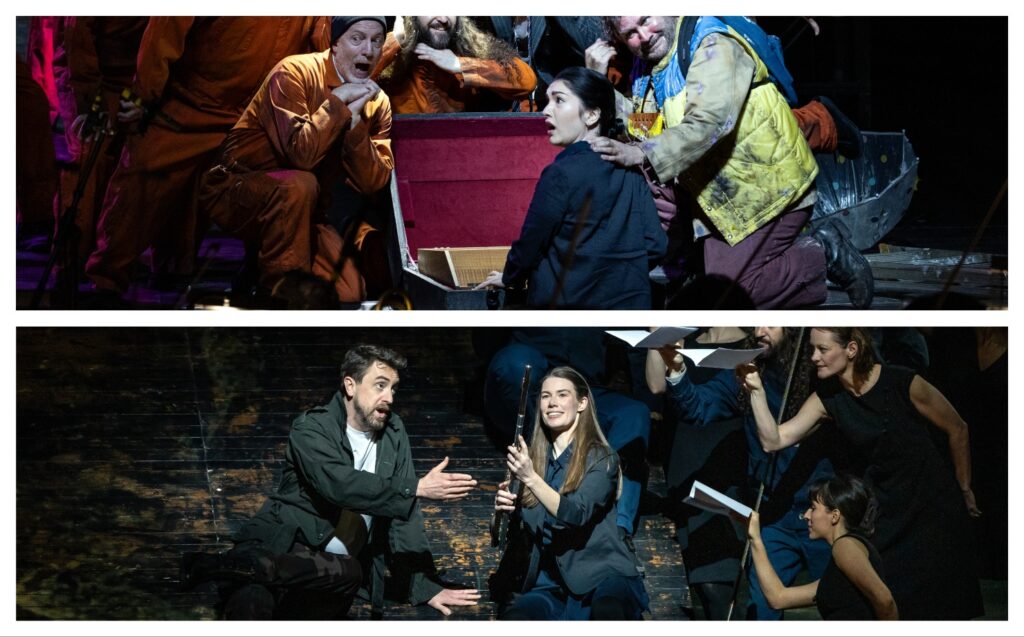
(Photo: Marty Sohl / Met Opera)
The actors in this production include Leo Abel, Antuan Byers, Julia Cavagna, Jay Dunn, Réka Echerer, Niara Hardister, Marty Keiser, Tina Mitchell, Dina Rose Rivera, Natalie Saibel, Stephan Varnier, and Collin Ware. Everyone was amazing in this production, and definitely worth bringing back for this revival. I highly recommend this season’s “Die Zauberflöte” for audience members of all ages and interests.
